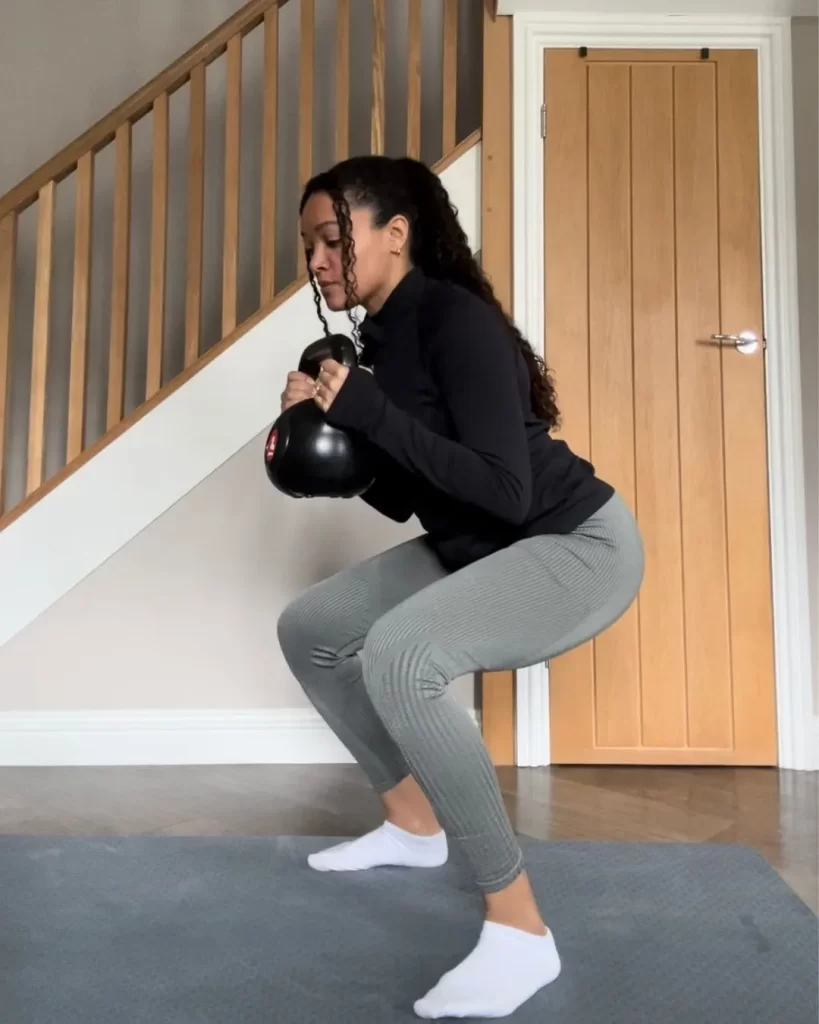As much as I enjoy working out, there’s nothing like a fresh fitness challenge to reinvigorate your routine. That’s why I decided to take on completing goblet squats every day for a week.
Now, I’ve tried various lower body exercises, from bodyweight squats to dumbbell squats, but goblet squats were a new territory for me in home strength training.
We often hear about the benefits of regular strength training for both body and mind. And after a week of daily strength training, I can attest to its effectiveness. So, could goblet squats be the next great addition to my workout regimen? Spoiler alert: after completing the challenge, it seems so.
As I discovered, these compound movements engage multiple muscles and joints, helping you progress from bodyweight squats to weighted exercises. They enhance core and grip strength while improving flexibility and range of motion. Goblet squats offer the same benefits as traditional squats, like strengthening quads and increasing bone density.
With this in mind, I committed to doing 30 goblet squats every day for seven days to observe the results. To learn more about goblet squats, how to perform them correctly, and my experience, keep reading.
What is a goblet squat?
“A goblet squat is a variation where you hold a weight, like a dumbbell or kettlebell, in front of your chest,” explains Sarah Ryan, a fitness expert PT at fitness app Ladder explains. “The weight you use depends on your ability and form mastery.” If you’re new to goblet squats, it’s wise to perfect bodyweight squats first before adding weight.
How do you do a goblet squat?
Proper form is crucial for any exercise to prevent injury and maximise results. Mari-Carmen Sanchez-Morris, a personal trainer, offers these instructions:
- Hold the weight close to your chest with both hands.
- Keep your elbows down and palms up, resembling holding a goblet.
- Stand with feet slightly apart and toes pointing outward.
- Maintain a straight posture with an engaged core and shoulders back.
- Lower your body by bending hips and knees, keeping weight on heels.
- Aim for thighs parallel to the ground, then return to starting position.

What’s the difference between a goblet squat and a traditional squat?
The key difference lies in how the weight is held and distributed, affecting mechanics and muscle engagement. In goblet squats, you hold the weight in front, engaging upper back and core muscles more than traditional squats, where you place the weight on your back.
Talk to me about the benefits of doing goblet squats.
Mastering squats is essential for any weight training program. Goblet squats not only strengthen lower body muscles but also engage the core effectively. Research suggests they’re beneficial during rehabilitation, improving hip, knee, and core strength.
Is it OK to do goblet squats every day?
While strength training is crucial, daily goblet squats might not suit everyone. NHS guidelines recommend strength training at least two days a week, emphasising the importance of rest days to prevent overtraining and injury.
I tried goblet squats every day — here’s how I got on.
Day 1-3: Laying the foundation
Armed with determination, I embarked on the challenge, starting with three sets of 10 reps each day, utilising only my bodyweight on the first two days. Focused on perfecting my form and mastering the movement, I concentrated on maintaining proper posture, engaging the core, and pausing briefly at the bottom of each squat.
By the third day, I upped the ante, introducing a 5kg dumbbell to the equation. While the technique remained consistent, the added resistance introduced a new level of intensity, leaving my muscles feeling thoroughly engaged and my heart rate slightly elevated.
Day 4-7: Rising to the challenge
As the week progressed, so did my confidence and strength. Armed with newfound vigour, I traded the dumbbells for an 8kg kettlebell on day four, further intensifying the challenge. The increased resistance demanded heightened core engagement, challenging my balance and stability with each repetition.
Days five through seven proved to be a true test of endurance and determination. Despite the fatigue setting in, I remained steadfast, pushing through the discomfort with unwavering resolve. Focused on maintaining proper form and technique, I found solace in the rhythmic repetition of the exercise, allowing my mind to quieten as my body powered through each set.
Reflections on my personal journey
As the week drew to a close, I couldn’t help but reflect on the profound impact this challenge had on my body and mindset. While I had initially underestimated the difficulty of goblet squats, they had humbled me in the best possible way, highlighting areas for improvement and growth.
In conclusion, my journey with goblet squats served as a poignant reminder of the importance of versatility and adaptability in fitness. By embracing new challenges and stepping outside of our comfort zones, we not only foster physical strength, but also cultivate resilience and fortitude in the face of adversity.
So, if you’re ever in need of a fresh fitness challenge, consider incorporating goblet squats into your regimen. Who knows? You might just surprise yourself with what you can achieve.
What are goblet squats good for?
Goblet squats offer a range of benefits, from strengthening lower body muscles to targeting the core effectively.
In conclusion, goblet squats proved to be a valuable addition to my workout routine, challenging me in ways I hadn’t anticipated. They’re a reminder that variety is key to fitness progress, and sometimes, trying something new can humble even the most experienced gym-goer.
This article was syndicated from Marie Claire UK
Translated and adapted by Praise Vandeh, Marie Claire Nigeria Content Writer

